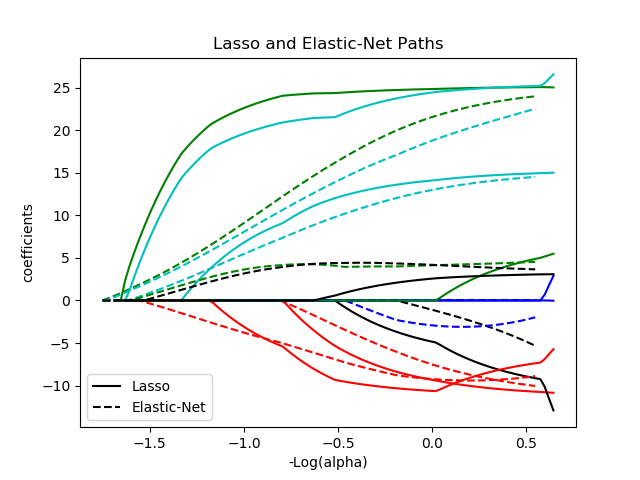sklearn.linear_model.enet_path?
sklearn.linear_model.enet_path(X, y, *, l1_ratio=0.5, eps=0.001, n_alphas=100, alphas=None, precompute='auto', Xy=None, copy_X=True, coef_init=None, verbose=False, return_n_iter=False, positive=False, check_input=True, **params)
[源碼]
計算具有坐標下降的彈性網絡路徑。
對于單輸出和多輸出,彈性網絡優化函數各不相同。
單輸出任務為:
多輸出任務為:
(1 / (2 * n_samples)) * ||Y - XW||^Fro_2
+ alpha * l1_ratio * ||W||_21
+ 0.5 * alpha * (1 - l1_ratio) * ||W||_Fro^2
其中:
||W||_21 = \sum_i \sqrt{\sum_j w_{ij}^2}
即每一行的范數之和。
在用戶指南中閱讀更多內容。
| 參數 | 說明 |
|---|---|
| X | {array-like, sparse matrix} of shape (n_samples, n_features) 用于訓練的數據。直接作為Fortran-contiguous數據傳遞,避免不必要的內存重復。如果 y是單輸出,則X 可以是稀疏的。 |
| y | {array-like, sparse matrix} of shape (n_samples,) or (n_samples, n_outputs) 目標值。 |
| l1_ratio | float, default=0.5 0到1之間的數字傳遞給彈性網(在l1和l2懲罰之間縮放)。 l1_ratio=1對應于套索(Lasso)。 |
| eps | float, default=1e-3 路徑的長度。 eps=1e-3意味著alpha_min / alpha_max = 1e-3 |
| n_alphas | int, default=100 沿著正則化路徑的Alpha數。 |
| alphas | ndarray, default=None 用于在其中計算模型的alpha列表。如果為None,則自動設置Alpha。 |
| precompute | ‘auto’, bool or array-like of shape (n_features, n_features), default=’auto’ 是否使用預先計算的Gram矩陣來加快計算速度。如果設置 'auto'讓我們決定。Gram矩陣也可以作為參數被傳遞。 |
| Xy | array-like of shape (n_features,) or (n_features, n_outputs), default=None 可以預先計算Xy = np.dot(XT,y)。僅當預先計算了Gram矩陣時才有用。 |
| copy_X | bool, default=True 如果為 True,將復制X;否則,它可能會被覆蓋。 |
| coef_init | ndarray of shape (n_features, ), default=None 系數的初始值。 |
| verbose | bool or int, default=False 詳細程度。 |
| return_n_iter | bool, default=False 是否返回迭代次數。 |
| positive | bool, default=False 如果設置為True,則強制系數為正。(僅當 y.ndim == 1時允許)。 |
| check_input | bool, default=True 跳過輸入驗證檢查,包括提供的Gram矩陣(假設提供),假設在check_input = False時由調用方處理。 |
| **params | kwargs 關鍵字參數傳遞給坐標下降求解器。 |
| 返回值 | 說明 |
|---|---|
| alphas | ndarray of shape (n_alphas,) 沿模型計算路徑的Alpha。 |
| coefs | ndarray of shape (n_features, n_alphas) or (n_outputs, n_features, n_alphas) 沿路徑的系數。 |
| dual_gaps | ndarray of shape (n_alphas,) 每個alpha優化結束時的雙重間隔。 |
| n_iters | list of int 坐標下降優化器為達到每個alpha的指定公差所進行的迭代次數。(當 return_n_iter設置為True 時返回)。 |
另見:
注
有關示例,請參閱examples/linear_model/plot_lasso_coordinate_descent_path.py.

